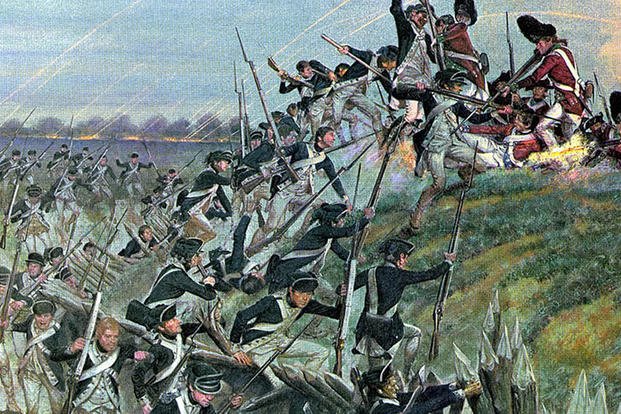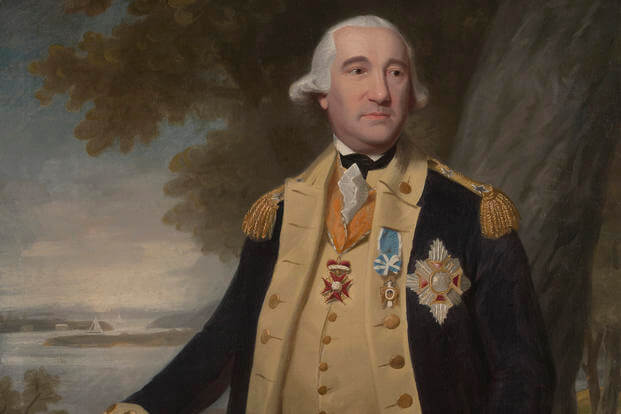When Baron Friedrich Wilhelm von Steuben arrived at Valley Forge on Feb. 23, 1778, one soldier likened him to “an ancient fabled God of War … a perfect personification of Mars.” Far from a mythological figure, though, he was a military officer from Prussia undertaking the biggest challenge of his career: building the American military basically from the ground up
“Our arms are in horrible condition, covered with rust,” von Steuben said after assessing the Continental Army. “Our men are literally naked, some to the fullest extent of the word.”
Two-and-a-half years after the start of the American Revolution, Gen. George Washington’s troops were not a pretty sight as they set up camp at Valley Forge. With the British occupying Philadelphia 20 miles to the southeast, the 12,000 soldiers fighting for their freedom planned to regroup through the harsh winter. As they did, they were not only lacking many essentials; they were tired, inexperienced and disorganized as well.
Enter von Steuben, a veteran of the Prussian army who would transform those ragtag soldiers into a cohesive, disciplined army with military principles that became the crux of “Regulations for the Order and Discipline of the Troops of the United States.” Some protocols in that training manual, first published in 1779, are still in use today.
Born in 1730, von Steuben was already an experienced military officer by the time he first observed the state of the Continental Army. He joined the Prussian military when he was 17 years old and fought in the Seven Years’ War, a far-reaching conflict involving battles in Europe and North America, where it was known as the French and Indian War. Von Steuben accrued much of his military knowledge while an aide-de-camp for Frederick the Great, the king of Prussia and an exceptional military strategist.
After he was discharged from the Prussian army in 1763, the debt-ridden von Steuben sought out military opportunities overseas to help pay off his financial obligations. After meeting with U.S. diplomats Benjamin Franklin and Silas Deane in France in 1777, von Steuben eventually headed across the Atlantic Ocean, agreeing to receive payment only if the Americans were victorious in the war and depending on his contributions to that potential outcome.
Having a noble title — von Steuben was conferred a baron in 1771 — mattered little at Valley Forge, “a dreary kind of place and uncomfortably provided,” according to Washington. The troops had already been there for two months when they first laid eyes on von Steuben, whom Washington had appointed as temporary inspector general with the rank of major general. Lacking vital resources and facing an outbreak of smallpox, hope was in short supply.
“[We were] in a truly forlorn condition — no clothing, no provisions and as disheartened as need be,” Pvt. Joseph Plumb Martin remarked of the brutal winter.
Realizing “no European army could have held together in such circumstances” and with no time to waste, von Steuben selected about 120 soldiers and began drilling them intensely, sometimes becoming so frustrated that he would curse at the men. Even though they might not have understood because von Steuben could not speak English, they likely got the gist.
Despite von Steuben’s foul language, he understood he was instructing a group of unskilled military men unlike any he had ever seen.
“In Europe, you say to your soldier, ‘Do this,’ and he does it,” von Steuben, who died in 1794 at the age of 64, wrote in his diary. “But I am obliged to say to the American, ‘This is why you ought to do this,’ and only then does he do it.”
In the end, the Americans took to von Steuben’s instruction. In a mere two months, soldiers learned how to load and fire a musket quicker and more efficiently, and were introduced to the bayonet, allowing them to engage more successfully when in close combat with British forces. They were taught a better way to march in sync, as well as a standardized infantry drill.
Von Steuben also gave the Army a blueprint for how courts-martial should be performed and protocols outlining the duties of each rank, relocated latrines away from living quarters and instituted a system of housing broken down by regiments and companies.
“They went from a ragtag collection of militias to a professional force,” Larrie Ferreiro, author of “Brothers at Arms: American Independence and the Men of France and Spain Who Saved It”, told Smithsonian Magazine in 2017. “[It was] Steuben’s ability to bring this army the kind of training and understanding of tactics that made them able to stand toe to toe with the British.”
The colonists’ first chance to display their newfound military knowledge in battle came nine days after they decamped from Valley Forge. In the largest, single-day battle of the Revolutionary War, the Americans emerged with what some viewed as a strategic victory at Monmouth, N.J., on June 28, 1778, greatly enhancing their morale.

Von Steuben remained with the Continental Army for the remainder of the war. After taking time away to write the 164-page “Regulations” manual — informally called the Blue Book because of its blue paper covers — the baron served in Gen. Nathanael Greene’s southern army and commanded a division at the Battle of Yorktown in Virginia in late 1781, the last major land battle of the war that resulted in a convincing American victory and precipitated peace talks.
After the Treaty of Paris was signed in 1783, von Steuben helped demobilize the Army, then resigned his commission. For his contributions in defeating the British, the baron — still deeply in debt — was bestowed land in New York, Pennsylvania and Virginia and awarded an annual lifetime pension of $2,500 in 1790. That’s a figure that would be worth more than $85,000 in 2024. For what he did for the American colonists, we’d consider that a bargain.
Want to Know More About the Military?
Be sure to get the latest news about the U.S. military, as well as critical info about how to join and all the benefits of service. Subscribe to Military.com and receive customized updates delivered straight to your inbox.
Story Continues
Read the full article here

